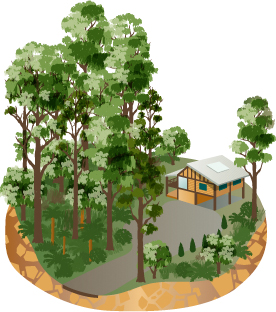Bushfires
Living near the bush means that we are more fire-prone, especially during the warmer months.
Understanding your level of risk is the first step in knowing what to do before and during a fire.
Depending on the type of fire risk your property is subject to, there may be different ways of managing your risks and getting prepared.
Recognising and understanding your risk environment will also help you to start preparing your property for fire.
Living close to or among rural grass or paddocks, near dense bush or open bush, or where bush or grasslands meet built up areas may mean different risks for you.
Use the tabs below to get prepared Before, During and After an event.
Before a Bushfire
STEP 1: Know Your Risk
Recognise the environment that you live in.
Close to or among grass or paddocks
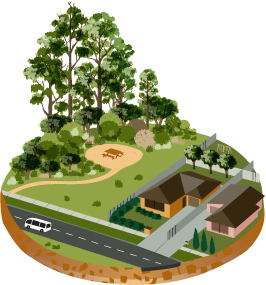
Close to or among dense or open bush
Where bush or grasslands meet built up areas

this and previous images from: https://www.rfs.nsw.gov.au/plan-and-prepare/know-your-risk
Go to the link below to understand what to expect in the different environments that you live in.
Check if you are in bushfire prone land.
You can check here to see if you are in a bushfire prone area
Go to the RFS Bushfire-Prone Landcheck
Get a bushfire risk report for your property from the Tweed Shire Council here:
Go to the Tweed’s Bushfire Risk Property Reports
Check how bushfire resilient your home is.
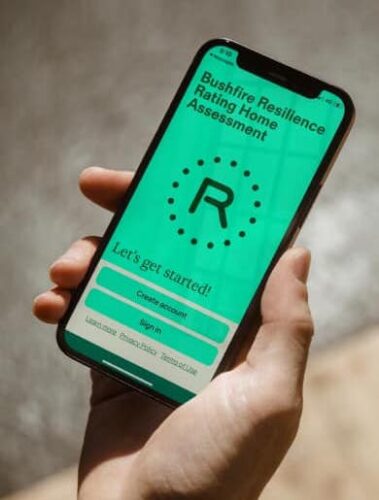 Australia’s Resilience Building Council have launched the world’s first free App to better prepare homes from bushfire risk.
Australia’s Resilience Building Council have launched the world’s first free App to better prepare homes from bushfire risk.
It takes around 20 minutes to assess your home using the App, which includes a free report and a customised action plan to improve the resilience rating of your home.
The App is available at rating.rbcouncil.org
Get the App ‘Bushfire Home Resilience’
STEP 2: Plan
Plan and prepare for the fire season.
Go to Tweed Shire Council’s page on planning and preparing for bushfires.
Go to the Tweed Bushfire Plan & Prepare page
Be aware of the daily fire danger ratings and total fire bans where you live.
Go to the RFS’ Fire Rating & Information page
The Bush Fire Danger Period
Starts on 1 September and goes through until 31 March.
During this time, fire permits are required on days when burning is allowed.
Depending on where (and what) you want to burn, you may also need a permit from Council (and need to get it off them before a permit can be issued from the RFS).
More information can be found here:
Go to the RFS’ Fire Permits page
For permits in Tweed call local fire control on 02 6671 5500
Watch the video below on how fireproof is your plan?
Make your bushfire survival plan.
As per any disaster, make a plan and get an Emergency Kit.
 Go to links below and get ready.
Go to links below and get ready.
Make your fire plan online or download a guide below and start the conversation.
You can also ask at your local brigade or the Uki CTC if they have any copies of the physical kits.
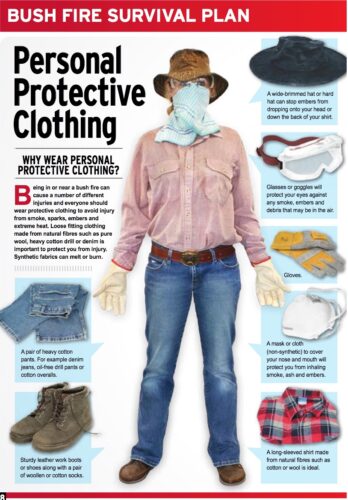
It is important to have adequate personal protective equipment (PPE) that could help you during fires.
Tools such as a rakehoe and a blower could help with managing fires.
Download the RFS’ Bushfire Survival Plan information
If you are asthmatic or have another lung condition …
Please read this article on 3 ways to prepare for bushfire season.
Prepare for Bushfire Season if you have a Lung Condition
STEP 3: Prepare
Prepare your property.
A well prepared home is more likely to survive a bush fire.
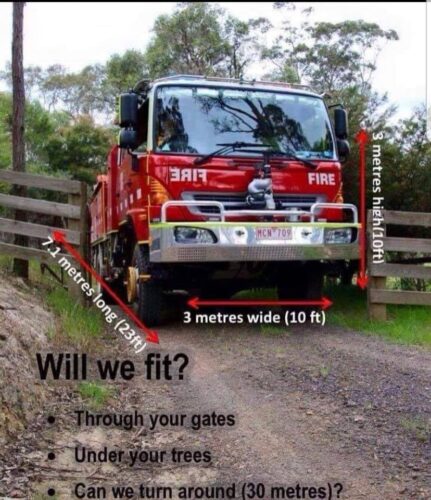
Will we fit ?
3 metres wide (10 ft)
7.1 metres long (23 ft)
3 metres high (10 ft)
Even if your plan is to leave early, the more you prepare your home, the more likely it will survive a bush fire or ember attack.
A well prepared home can also be easier for you or firefighters to defend, and is less likely to put your neighbours’ homes at risk.
A well prepared home will also give you more protection if a fire threatens suddenly and you cannot leave.
Go to the RFS link below for tips on preparing your property.
Go to the RFS’ page ‘Prepare your Property’
Download the ‘Prepare your home’ fact-sheet to help you with some simple, step-by-step things you can do around your home.
Download the fact-sheet ‘Prepare Your Home’ as PDF
Make an emergency plan for your animals/livestock.
You are responsible for your animals.
Consider making an animal Evacuation Kit, tag your animals for identification and identify family or friends who can help care for your animals in the event of a fire.
If you have livestock and large animals on your property, it is important to take steps to plan for their welfare in the event of a fire.
Download the fact-sheet below to help you.
Download the fact-sheet ‘Lifestock & Large Animals’ as PDF
Prepare yourself and your family.
Prepare an emergency survival kit before the bush fire season starts.
Having a prepared kit means having easy access to things that can help you survive a bush fire or other natural disaster.
It will be in one handy location.
Read the link below for tips from the RFS on preparing your survival kit.
Go to the RFS’ page ‘Emergency Survival Kit’
The AIDER (Assist Infirm, Disabled and Elderly Residents) program is a free, one-off service by the RFS which supports some of our most at-risk community members.
The AIDER program is designed for people who have limited domestic support available from family, relatives, friends or other services.
This could include older people, people living with a disability, and people who are already receiving community assistance and services.
Their property must also be on bush fire prone land (land that can support a bush fire or be subject to bush fire attack).
For more information, contact the AIDER Team:
P: 02 8741 4955
E: aider [at] rfs.nsw.gov.au (substitute [at] with the @ symbol)
W: www.rfs.nsw.gov.au/plan-and-prepare/aider
Check out the ‘Wildlife Bushfire Safety Tips Fact-sheet’ information below from WIRES on how to help wildlife.
Join your Neighbourhood Group & get to know your Neighbours.
If you are not already part of your neighbourhood hub, find and connect with your Neighbourhood Leader if you live in the Greater Uki area.
Get to know your neighbours.
You don’t have to best friends, it’s just good to know who your neighbours are (and who might need help or be able to offer help in an emergency).
Go to RUKI’s ‘Neighbourhood Groups’ page
Check the useful advice below from the SES on helping each other out.
Go to the SES’ ‘Look out for Each other’ page
To stay informed, go to the useful apps & links page to download relevant apps and links.
The Hazards Near Me app uses the new Australian Warning System across fire, flood and tsunami warnings.
Yellow means ‘Advice‘ – an event has started and there’s no immediate danger but you should stay up to date.
Orange means ‘Watch & Act‘, which means things are changing and it’s time to start taking action to protect you and your family.
Red is the highest level of alert and it means you need to take action immediately.
Read more at ‘australianwarningsystem.com.au‘
Go to ‘australianwarningsystem.com.au’
Download the ‘Hazards Near Me’ App
During a Bushfire
Follow your bush fire survival plan.
If you do not have a bush fire survival plan, ensure you know what you will do before, during and after the fire.
Remember – Leaving early is your safest option.
If you have a UHF radio, make sure it’s charged in case other communications go down.
Tune in to alerts and updates through the following media.
- Listen live to ABC North Coast or tune in at 702AM / 94.5FM
Listen live to ABC North Coast
- Download the ‘Hazards Near Me‘ App
NSW RFS – Northern Rivers Zone FB page
- Bushfires Information Line call 1800 679 737
Follow:
The Caldera Community Emergency Support page is run by Tweed Shire community volunteers to share official, timely updates and reliable information about disasters and emergencies.
Go to the Caldera Community Emergency facebook page
Other community pages that may be useful:
- Depending on where you live, you may have a specific local Facebook group (there are several in Uki, there’s a Byrrill Creek Group, Kunghur and Mount Burrell have a group, etc.
ARrcGIS NSW Fire Map
Additional to the Hazards Near Me app, this is a handy mapping tool to see where current fires are in NSW, and draws from RFS data:
Enact your Bushfire Survival Plan &
locate your Emergency Kit !
After a Bushfire
The following list provides contacts of support services directly related to bushfire recovery assistance
- Specialist mental health Bushfire Recovery Clinicians are available in bushfire-affected regions across NSW.
To get in contact with a Bushfire Recovery Clinician, contact the NSW Mental Health Line on 1800 011 511
Do you need support after the bushfires?
Go to the link below for information on mental health and well-being support.
Go to the Health & Mental Health page
Connecting with your community and/or neighbours is important following a natural disaster.
Check in on each other and help each other out.
Go to the link below to connect with your Community and Neighbours.
Go to RUKI’s ‘Neighbourhood Groups’ page
Check out the link below on Preparing to Return Home after a bushfire
Download the ‘Returning Home’ from the Red Cross as PDF
Check out the CSIRO tips below on Replanting your Garden after a bushfire
Go to the CSIRO’s page ‘Replanting your Garden’
Tune in to alerts and updates through the following media.
- Listen live to ABC North Coast or tune in at 702AM / 94.5FM
Listen live to ABC North Coast
- Hazards Near Me App
NSW RFS – Northern Rivers Zone Facebook page
- Bushfires Information Line call 1800 679 737
Tweed Shire Council Facebook page
Follow:
The Caldera Community Emergency Support page is run by Tweed Shire community volunteers to share official, timely updates and reliable information about disasters and emergencies.
Go to the Caldera Community Emergency Support Facebook page
ARrcGIS NSW Fire Map
Additional to the Hazards Near Me app, this is a handy mapping too to see where current fires are in NSW, and draws from RFS data:
Enact your Bushfire Survival Plan &
locate your Emergency Kit !
Stay informed and go to the useful Apps, Numbers & Links page to download relevant apps and bookmark links.
To report a Fire Emergency call
Triple Zero (000)
If you are Deaf or have a Speech or
Hearing Impairment call 106
